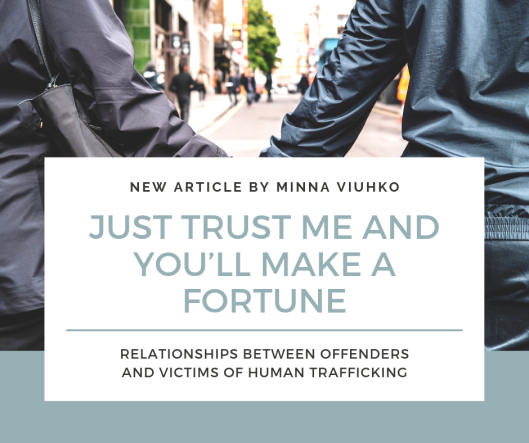Just trust me and you’ll make a fortune – relationships between offenders and victims of human trafficking

A new article by HEUNI researcher Minna Viuhko has been published in the Nordic Journal of Criminology.
Minna Viuhko has studied human trafficking more than ten years (you can access some of her previous work here: HEUNI Report series 62, HEUNI Report series 67, HEUNI Report series 68, HEUNI Report series 82) and in her latest article she focuses on the relationships between offenders and victims of trafficking.
In her article, Minna notes that despite the increasing amount of research on human trafficking, certain aspects of the phenomenon have remained less studied. For many years, research focused on trafficking for sexual exploitation and men-exploiting-women cases. Recently, the body of literature has become more diverse, and different forms of trafficking have been recognised. However, the trafficking research has largely ignored the notion of intersectionality, although intersectionality has been applied in several studies, for example, on domestic violence. The intersectional analysis would have a lot to offer also for trafficking research and in her study, Minna has applied the intersectional approach to analyse what factors make trafficked persons prone to exploitation and, on the other hand, keep them in the exploitative situations and relationships.
The article deals with the relationships between offenders and trafficked persons and the data consists of trafficking in human beings court judgments from the Finnish courts. The study asks what is the nature of the relationships between victims and offenders. The study identifies various situations and contexts in which trafficked persons are exploited and different kind of relationships between the actors involved. The cases studied are related to forcing persons into prostitution, to sexual exploitation, and to working in poor and substandard circumstances without or with very low salary in different sectors of the labour market. The relationships between the exploited person(s) and the offender(s) vary from friendship to kinship, to an intimate relationship or to a professional relationship.
The study also focuses on the power relations between the parties involved. The study shows that the exploitative relationships between offenders and trafficked persons display many features of unequal distribution of power. Furthermore, the analysis shows that many intersecting factors are linked to the victimisation of trafficked persons. To find out more about the findings, read the article in the Nordic Journal of Criminology.
In case you are not able to access the article or have other questions regarding the topic, please contact Minna via e-mail.